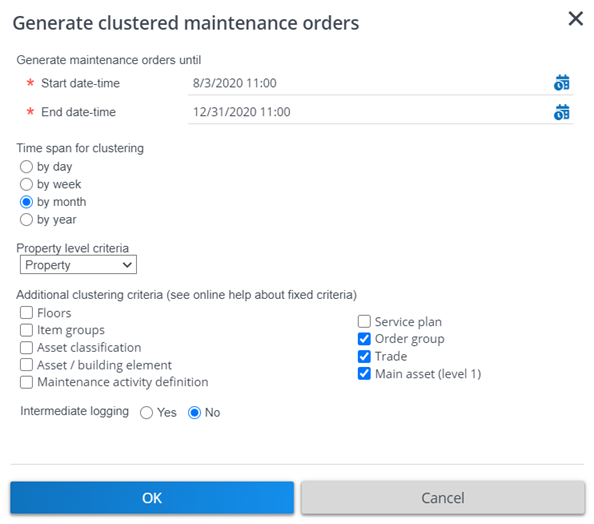Generating clustered maintenance orders
It may be efficient to generate a limited number of maintenance orders for related maintenance activities, instead of generating one maintenance order per maintenance activity. For this purpose, you can make settings to cluster maintenance activities during the order generation, by specifying certain fixed criteria and optional additional criteria, and an end date.
Steps
• In the Standard orders TSI, special standard orders must be configured that can be used to generate maintenance orders with clustered activities.
• In > orders can be generated, based on clustered activities. Once maintenance orders are generated, they become available in Work Orders .
If you want generate maintenance orders with clustered activities, the following preconditions apply: the corresponding maintenance plan is set to Definitive and has the Active status. The field Clustering allowed (Y/N) of the selected activity definitions must be set to Yes. |
Fixed clustering criteria
The activities of selected activity definitions are automatically clustered according to the following fixed criteria:
• Standard order
• Property
◦ Default: Property - maintenance activities are clustered per property
◦ optional: Property level 1 - clustering by the property's main level: all activities related to properties on the first level, related second level and related third level in the property tree are clustered
◦ optional: Property level 2 - clustering by the property's second level: all activities related to properties on the second level and related third level in the property tree are clustered
• Main asset - clustering defaults to the main asset, unless the additional criteria Asset / building element is enabled.
• Contract line
• Budget definition
• Outsourced assignment (this is a subcontractor contract line, which is only applicable in > ) See Service Providers > Subcontractors > Generating outsourced assignments for more information.
Example
The activities of four selected activity definitions share the same standard order and property. They are consequently clustered under one maintenance order. However, if one of the four activity definitions in the selection has a different trade than the other three, its activities are clustered under a separate maintenance order and thus two maintenance orders will be generated instead of one.
Additional criteria
Apart from the automatic clustering criteria, you can also select additional criteria:
• Floors
• Item groups
• Asset classification
• Asset / building element
• Maintenance activity definition
• Service plan
• Space
• Work type
• Planon administrators can add to this list of additional clustering criteria. These configurable criteria are available in Field definer as business object settings for Base activity definitions. Example: your administrator adds Work type, Asset classification, Service plan, Rentable unit , Asset and Space as additional clustering criteria. • If you select reference fields such as rentable unit, space or asset as a clustering criteria, the corresponding field in a generated order is automatically populated. • If various maintenance activities with different spaces and / or assets are clustered in the same PPM order, the Space and / or Asset field value is taken from the standard order. For more information on making these settings see Field definer > Adding additional clustering criteria for Maintenance Planner. |
Procedure
1. At Definitions & schedules, select the activity definitions whose activities you want to cluster into one or more maintenance orders.
2. On the toolbar, click Generate clustered orders.
The Generate clustered maintenance orders dialog box appears.

3. At Generate maintenance orders until specify the end date-time until which you want to generate maintenance orders for the selected activity definitions.
By default, the end date-time is set to the current date, 23:59. In the date picker, you can edit this date-time as required.
4. At Property level criteria, select the property level by which you want to cluster.
5. In Time span for clustering and Additional clustering criteria select criteria by which you want to cluster the activities. For example: if you select by month, by Order group, by Main asset level and by Trade, activities are clustered by month of execution, by order group, main asset and by trade. Each cluster that is subsequently formed is assigned to a single maintenance order.
Depending on the selected criteria, one or more maintenance orders will be generated.
6. In the Intermediate logging field, select whether you want to activate intermediate logging during the order generation.
Intermediate logging is set to No by default, to prevent the system's performance from potentially being adversely affected. This means that log results are only stored when the background action for order generation has ended. If you want to monitor the background action's progress more closely, you can set intermediate logging to Yes, but bear in mind that this may slow down the system's performance. The same setting is also available for scheduled PPM order generation via a PPM cluster profile. For more information on that topic, see PPM profile and PPM profile fields.
7. Click OK to start the order generation as a background action.
See Supporting data > Background actions for more information.
8. Once the order generation is completed, the generated maintenance orders become available in the Work Orders TSI > .
Good to know: if all activities of a maintenance order have the same description, the description of these activities is copied to the description of the generated maintenance order, instead of the description of the standard order.
The individual activities of a selected maintenance order are displayed as read-only items at Order details > Maintenance activities.
9. At > , on the Status transitions action panel, you can change the status of individual activities. If the maintenance order status is changed to Technically completed or Administratively completed the corresponding activities are also assigned the Completed status.
If a planned maintenance order is completed (administratively or technically), the open subrequisition for materials is also set to Administratively completed or Technically completed.
If a planned maintenance order is canceled, any open subrequisitions for materials are also set to Canceled.